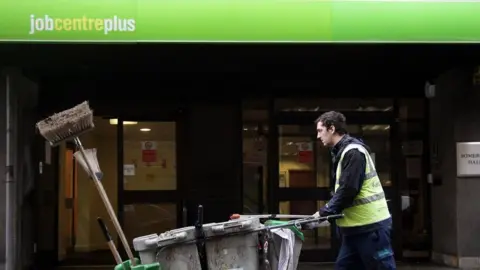Scottish unemployment rate remains unchanged
 Getty Images
Getty ImagesScotland's unemployment rate from December 2020 to February 2021 remained at 4.4%.
The Office for National Statistics (ONS) said the employment rate, for those aged 16 to 64, over the same period was 74.6%.
This was up 0.2% on the previous quarter.
There were 2.567 million people aged 16-64 in employment between December and February, while 120,000 in that age range were unemployed.
Darren Morgan, director of economic statistics at the ONS, said: "The latest figures suggest that the jobs market has been broadly stable in recent months after the major shock of last spring."
UK-wide, the unemployment rate fell to 4.9%.
According to the ONS, some 1.67 million people were unemployed between December and February. That is down 50,000 on the previous quarter but still 311,000 higher than a year ago.
It said young people continued to bear the brunt of the crisis, amid large-scale job losses in sectors such as hospitality and retail.
People under 25 accounted for more than half of the payroll jobs lost in the year to March, it said - some 436,000 positions.

'It's hard to find places taking on staff'

Niamh Welsh, who lives in Paisley, is a student but prior to the pandemic had been working part time in retail. She was furloughed, then lost her job earlier this year and has struggled to find other work.
"I've been working since I was about 13, doing paper rounds, and then I properly started working when I was about 15 years old, so I've been working for the last eight years or so," she says.
"So I would have thought it would have been a little bit easier, but just with the situation it's quite hard to find places that are taking on staff, as most places have been laying off staff or cutting down hours.
"Even all the supermarkets, which I have experience of, barely any of them have any positions at all."
Niamh is due to graduate this summer and had hoped to work and save money in order to return to education.
"This year I was planning to make some money but that's tricky if I can't find a job.
"I want to stay here but I've got a flat to pay for, bills to pay, food, all that stuff, but I also want to be able to save."

Stuart McIntyre, head of research at the Fraser of Allander economic institute, said the latest data suggested some "worrying trends" were emerging.
He said: "The number of young people who are unemployed has jumped by 15,500 over the last year, with the youth unemployment rate rising from 8.3% to 13.5%.
"The closure of large parts of the hospitality and retail economy through the pandemic, sectors where many young people find work, is clearly feeding through."
Dr McIntyre also said the north east of Scotland continued to experience a much larger decline in payroll employment than elsewhere in Scotland, as a result of the combined effect of the downturn in oil and gas and wider effects of the pandemic.
He added: "Coupled with the recent announcement of the closure of John Lewis in Aberdeen, it is clear that this is one part of the Scottish economy that is facing particularly acute challenges."


Unprecedented measures to avoid a rise in unemployment, including the furlough scheme, have kept down the number of people looking for jobs at only 4.4% of the Scottish adult workforce.
That's the same in December to February as in the preceding autumn months and below the UK figure, which fell slightly.
The number in work was up, but remained below the UK rate, and the claimant count was little changed at 212,000 people, depending on benefits linked to unemployment or low pay.
That figure nearly doubled at the start of the pandemic.
The number of Scots in payrolled jobs dropped by 73,000 in the year to last month.
Less robust figures from the ONS suggest job vacancies across the UK rose in March and that may have accelerated this month.
